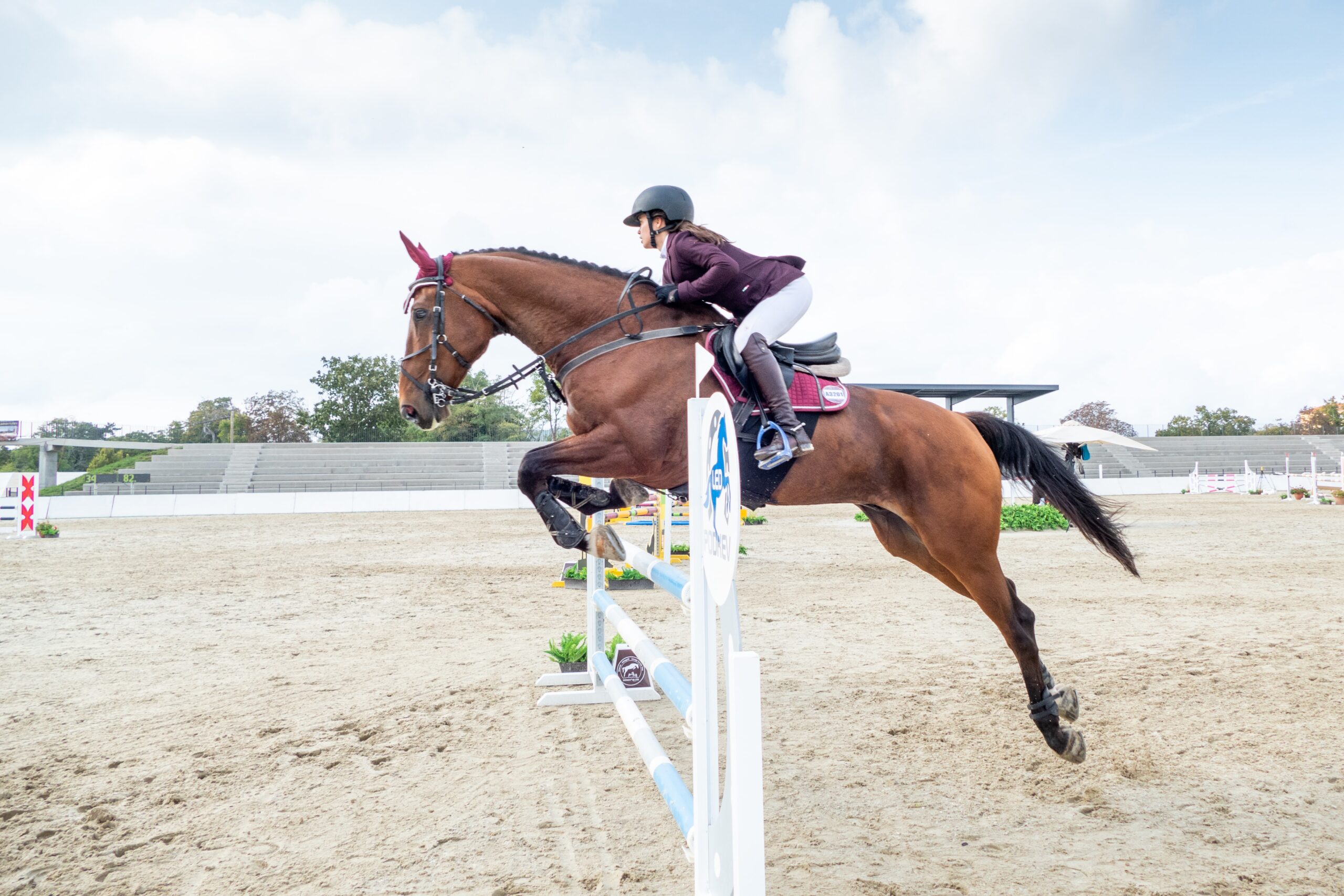Caroline’s Story:
Riding a horse may seem scary for many people. Not for me. I love to ride. As a child, I rode my first pony on an amusement ride, with my grandfather at my side. As I grew older, I went to summer riding camps. As an adult, I took lessons weekly until I bought my own horse.
Trueno was my beloved five-year old dappled grey horse. We were a team. I bought him as a tall three-year old horse because I loved to jump. Taller horses could make it over the higher fences. It didn’t matter that this would be the first time I had trained a horse because I had been riding for over ten years and I wanted a challenge.
After initially working with Trueno for several months, my instructor and I started him jumping over fences. A standard fence has two wooden posts, eight feet apart, with a pole hung between them resting on a thin plate at each end of the pole. If the horse lightly rubs the pole with his foot while jumping the fence, the pole will easily fall. The height is increased by raising the two thin plates a notch on the post, three inches at a time. A tall horse can easily jump or walk over a one-foot-high fence.
With the goal to jump, I began to question what height and when. A one-foot-high fence rests too low to the ground. A two-foot-high fence serves as a challenge. With any training program, one usually gradually increases the challenge. Trueno and I started with one-foot-high fences and progressed. Trueno improved with practice. I had to maintain a correct position for both Trueno and myself, to prevent a fall if Trueno decided last minute to stop abruptly.
With about a year of practice, our jumping had progressed to two feet. My instructor knew I could jump higher. He was ready to see how high Trueno was willing to jump. My instructor had a lot of experience training horses and could read a horse’s willingness through the horse’s ear, head, and tail movements. One day he said, “Let’s see how high Trueno can go today.”
Really? We had just started jumping two feet reasonably well. While it is reasonable to test an athlete’s abilities and then return to the current training level, my uneasiness with the proposed increased height began to set in. I’m not ready, I thought. I knew Trueno could jump two feet, but I questioned the timing of trying to jump higher. I could always say no if I felt unsafe with the increasing height. And I knew I could trust my instructor to know both my own and Trueno’s capabilities.
I responded, “Okay, let’s try.”
And so we began to see what Trueno could do. Two feet, three inches … two feet, six inches … two feet, nine inches. Could we go higher? Trueno cleared three feet next. I think I can try one more, I thought. Three feet, three inches. Trueno rubbed the pole with his back foot and the pole fell. We tried again. This time he lifted his feet higher and didn’t knock down the pole. Wow! I had no idea Trueno and I could clear that height today. My instructor now raised the height again, to three feet, six inches. Doubt in my ability started to settle in. We made it over the last time, but what if he stops this time without going over? What if I fall off? I told my instructor I thought we should not attempt going any higher today.
My instructor called me over to talk. As I sat in the saddle on Trueno, my instructor shared a message I will never forget. “Caroline,” he said, “I need to tell you something about having faith in God. When we walk with God by faith, God has us. We can trust God. When we have fear, we cannot have faith at the same time. Either you can approach the jump with fear, or you can approach the jump with faith. You cannot approach the jump with both. Which approach do you want to take?”
I believe my instructor had the best of intentions, but his message was not exactly accurate. It’s not that we must eliminate all fear to have faith, but that our faith must increase in the presence of fear so that we can lean on God during the times we are afraid. Jesus exemplified faith in the presence of fear in his prayer in the Garden of Gethsemane. Because of who God is and what he has done, we can trust God despite our fears when he calls us to walk through challenging circumstances.
A horse can sense a rider’s fear. If I were tense in the saddle, Trueno may have hesitated in jumping the fence. By choosing to relax and lean into the faith I had in my horse and my instructor’s judgment, I could be confident my horse would respond and clear the fence. Riding relaxed helps accomplish the goal safely.
We can clear three feet, six inches today, I determined as Trueno and I picked up our pace. I set him up, positioning him exactly where he could be prepared to see the fence ahead and place his feet in front of it to leap. I kept repeating in my mind, We can do this.
We did it! We cleared three feet, six inches!
The jump was an exhilarating accomplishment, but I will most remember the lesson of having faith in the face of fear. Psalm 55:22 says, “Cast your cares on the Lord and he will sustain you.” We rest our faith in God because he has proven himself worthy.


